Table of Contents
Name
Binomial: Grass carp
Scientific name: Ctenopharyngodon idella
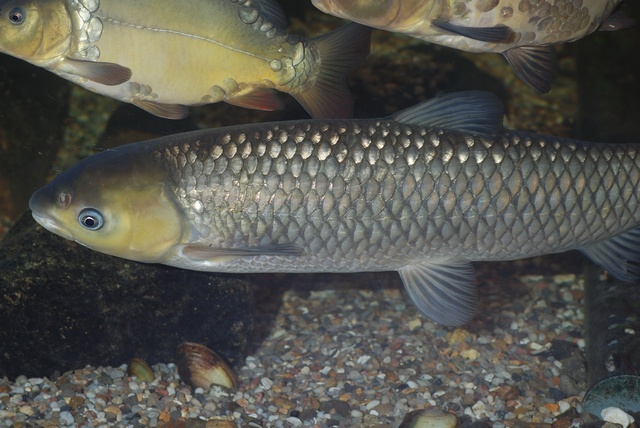 |
| Permission granted by Byron T. Bezdek of Aquatic management LLC |
Etymology
This species is also known as White Amur because it is native to the Amur river which forms the border between Russia and China (Shireman & Smith, 1983)
.
Taxonavigation
Kingdom: Animalia
Phylum: Chordata
Class: Actinopterygii
Order: Cypriniformes
Family: Cyprinidae
Genus: Ctenopharyngodon
Species: Idella
(Shireman & Smith, 1983)
Diagnosis
The grass carp is usually the largest fish in size in the Cyprinidae family. It is long in its adulthood, has a flat head and a round abdomen. Its gills are small and short and are arranged in a scattered manner. Its pharyngeal teeth is usually in 2 rows arranged in 2-5 OR 4-2 manner. It is usually silvery white in colour due to the scales and has a grey abdomen and lighter coloured fins (Shireman & Smith, 1983)
Relevance to Singapore
Grass carps have been extensively cultured in Singapore for food. They are reared in places such as Yeo Aquarium and are sold in fish markets.
Special features
Sometimes, grass carps do not have fully covered scales as shown in the figure below. The first linear-scaled grass carp was spotted in Kentucky in 2009. Experiments are now ongoing to search for the cause for the loss of scales. There were also cases of mirror-scaled grass carps which only have 1 row of scales near the dorsal fins surrounding the body. There are 2 genes, S gene and N gene, involved in the loss of scales in carps. The first gene has been discovered to be Fibroblast Growth Factor 1 (FGFR1), the S gene (Rohner, et al., 2009). However, the N gene has yet to be found.
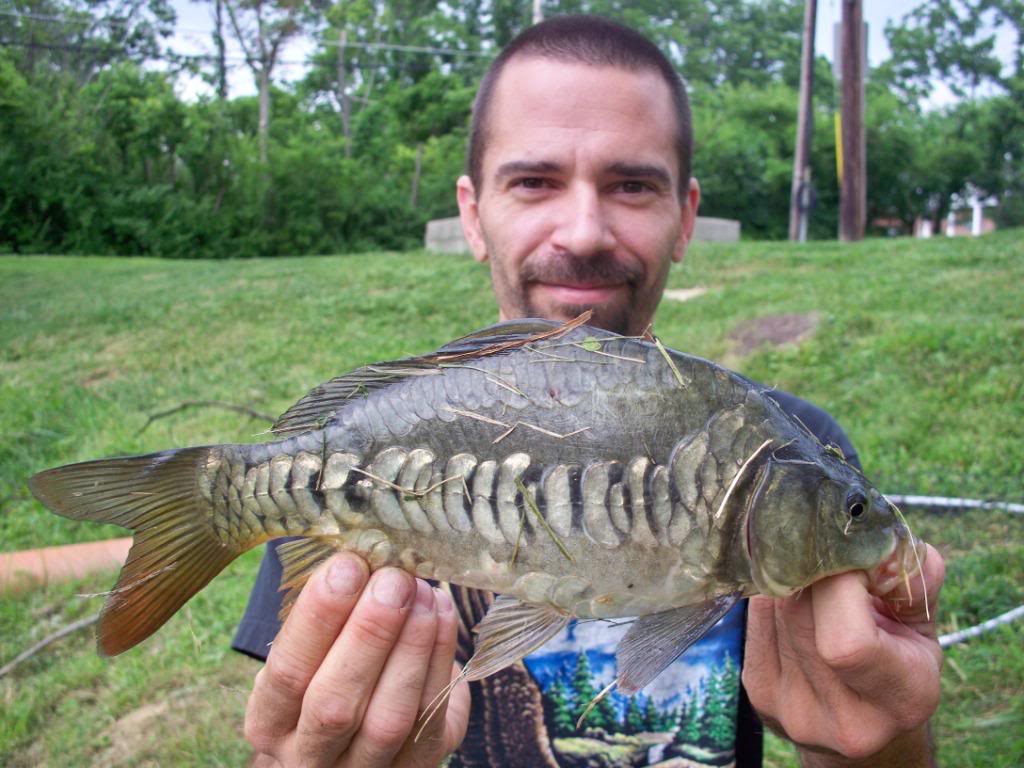 |
| The first linear carp found by Mike in Kentucky, USA |
Description
AdultColor: Body is usually silvery white due to its scales.
Dorsal ray fins: Usually 7 to 10 rays
Abdomen: Light grey in colour
Scales: They are usually full scaled. However, in recent times, they have found grass carps of various scale patterns like linear-scaled.
Pharyngeal teeth: It consists of 2 rows of teeth usually arranged in 2-5 or 4-2 manner.
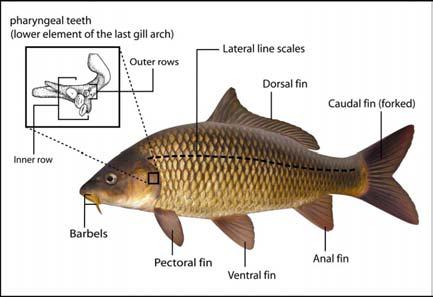 |
| Parts of a carp. Permission granted by Laura Casas |
Biology
Feeding habits
The grass carp feeds on aquatic plants all the time. The young of grass carp feed on planktonic algae. At temperatures below 10 °C, they feed on tender aquatic plants. At temperatures above that, they are less fussy and feed on a wide variety of aquatic plants. The amazing fact is grass carp feed on aquatic plants 3 times its own weight within a day. Due to this, the grass carp has been used by the United States and Eastern Europe as a form of aquatic weed control because these countries spend a lot of money every year clearing these weeds in rivers. It was more cost effective to introduce grass carp in rivers as a natural agent (Krykhtin & Gorbach, 1981).
However, there is also much controversy with the grass carp as a form of invasive species because the grass carp must not affect the natural ecosystem and the habitat of native fish species. If native fish species depend on weed as their food source and as a source of spawning sites, introducing the grass carp would not be desirable(Cross, 1969). One possible solution is to introduce a triploid grass carp (72 chromosomes) which is sterile so that the population can be controlled by humans should the grass carp be an invasive species (Bjergo, Boydstun, Crosby, Kokkanakis, & Sayers, 1995).
Reproduction
The grass carp is heterosexual and it usually takes about 5 to 9 years to be sexually mature (gonads fully grown). The gonads usually differentiate at 50 to 60 days old. Temperatures of the water should be relatively higher (above 20 °C) and food should be abundant before they can spawn. Breeding can also be induced by injecting hormones into the pituitary glands of the grass carps. The estrous cycle can be seen when the males chase the females and bump against the females’ abdomen. Their pectoral fins will also move very quickly. Then at the climax, both the males and females will release the milt and eggs. Fertilization then occurs in the water. Under optimal conditions, the young will then emerge from the eggs within 20 hours after fertilization. The young immediately feeds on algae, rotifers and protozoans (Krykhtin & Gorbach, 1981).
The grass carp can reach up to 1 kg in the first year and grow about 2 kg in temperate areas and 4.5 kg in tropical areas.
Diseases
There is a huge concern that the grass carp is able to transfer parasites to other organisms. The most common is the Asian tapeworm (Bothriocephalus opsarichthydis) which is native to China. When the grass carp was first introduced in North America, this tapeworm was found in several species there. This tapeworm is now widespread in North America. It either kills the individuals or weakens them (Shireman & Smith, 1983).
Distribution
The grass carp is native to eastern China as shown in the map below. The grass carp originally occurs in the Amur, Ussuri and Sungari rivers and in Lake Khanka. They can also be found in the Southern China rivers such as the Liao, Hai, Yellow, Hwai, Yangtze, Pearl, East, Chientang, and Min rivers. Subsequently, the grass carps have been introduced to over 50 countries and have become established in 3 countries outside its native origin, Japan, USSR and Mexico. They have also reproduced in Phillipines, Taiwan, Yugoslavia and USA (Shireman & Smith, 1983)..
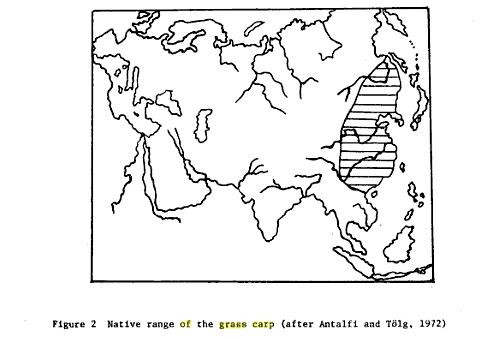 |
| Taken from "Synopsis of biological data on the grass carp, Ctenopharyngodon idella (Cuvier and Valenciennes, 1844) |
-----------------------------------------------------------------------------------------------------------------------------------------------------------------------------------------------------------------------------------------------------
Carp Genomics
The grass carp has 48 chromosomes (2n). Although the grass carp genome has not been sequenced, the first grass carp linkage map has been generated over here in Singapore at the Temasek Life Sciences Laboratory (Xia, et al., 2010). A linkage map is a genetic map which shows the position of known genes relative to each other on each chromosome through the usage of unique microsatellite markers of each gene (Liu, Xia, Bai, Fu, Li, & Yue, 2009) which is then mapped on a linkage map. Each linkage group corresponds to each chromosome.
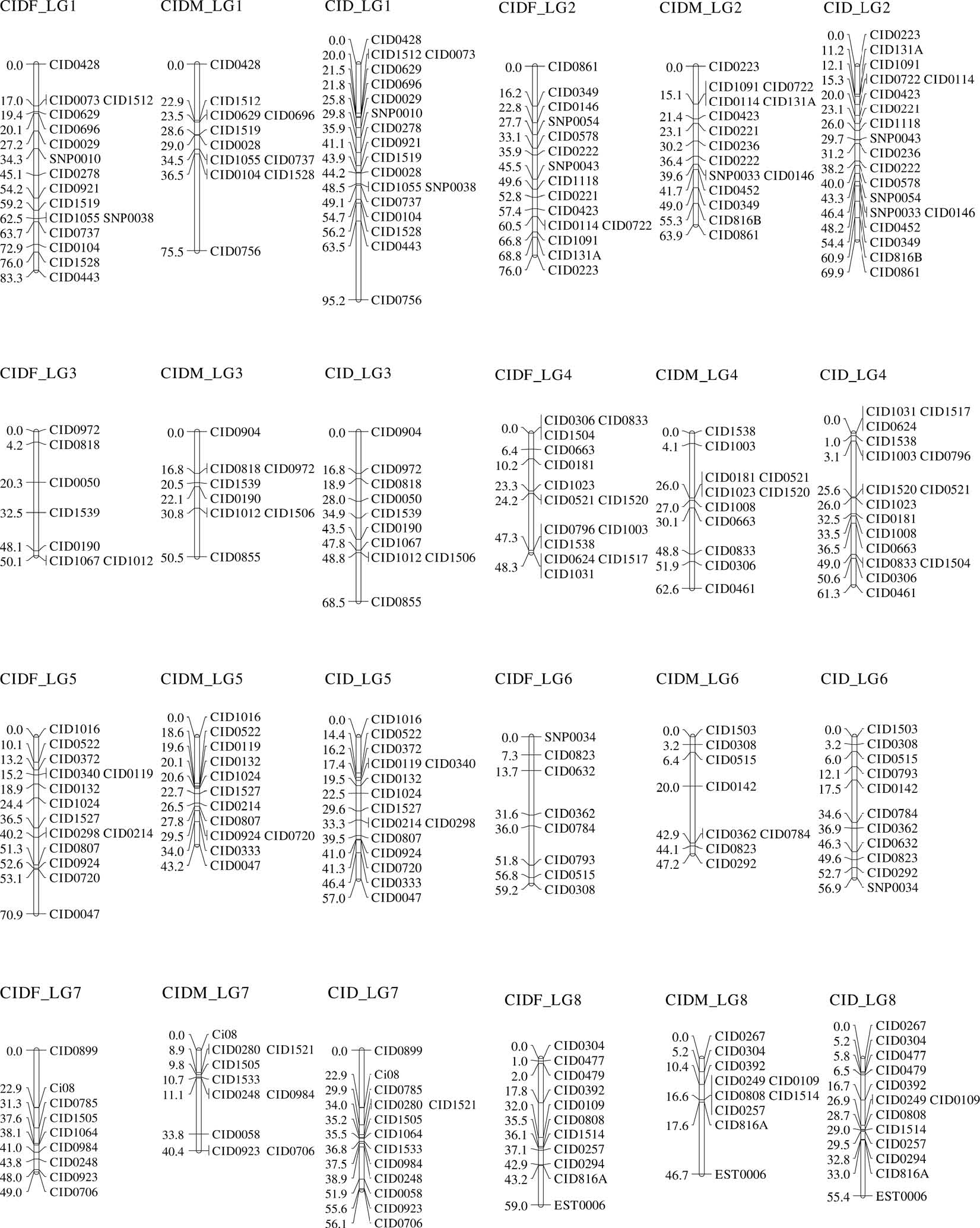 |
| Linkage groups 1 to 8 |
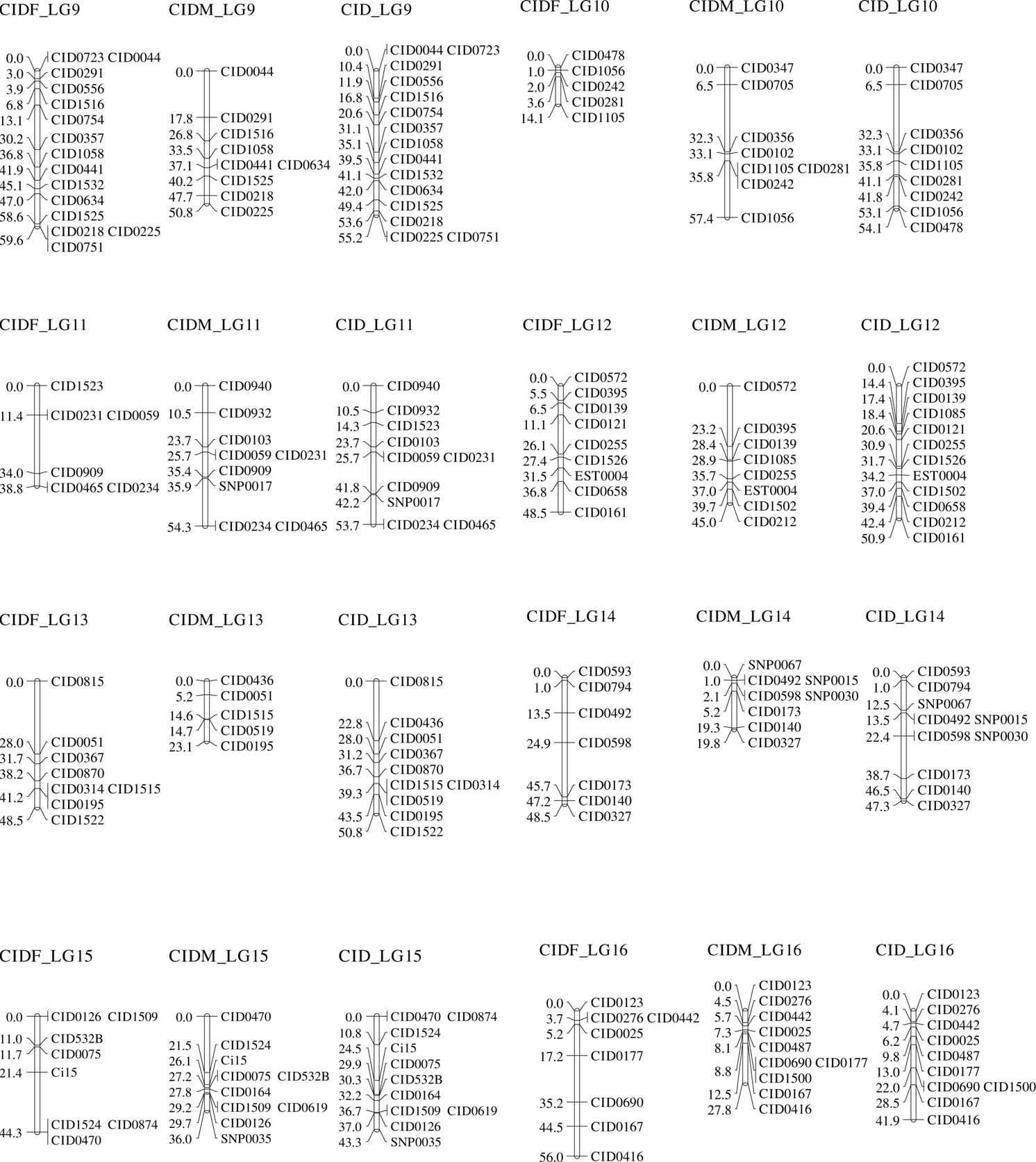 |
| Linkage groups 9-16 |
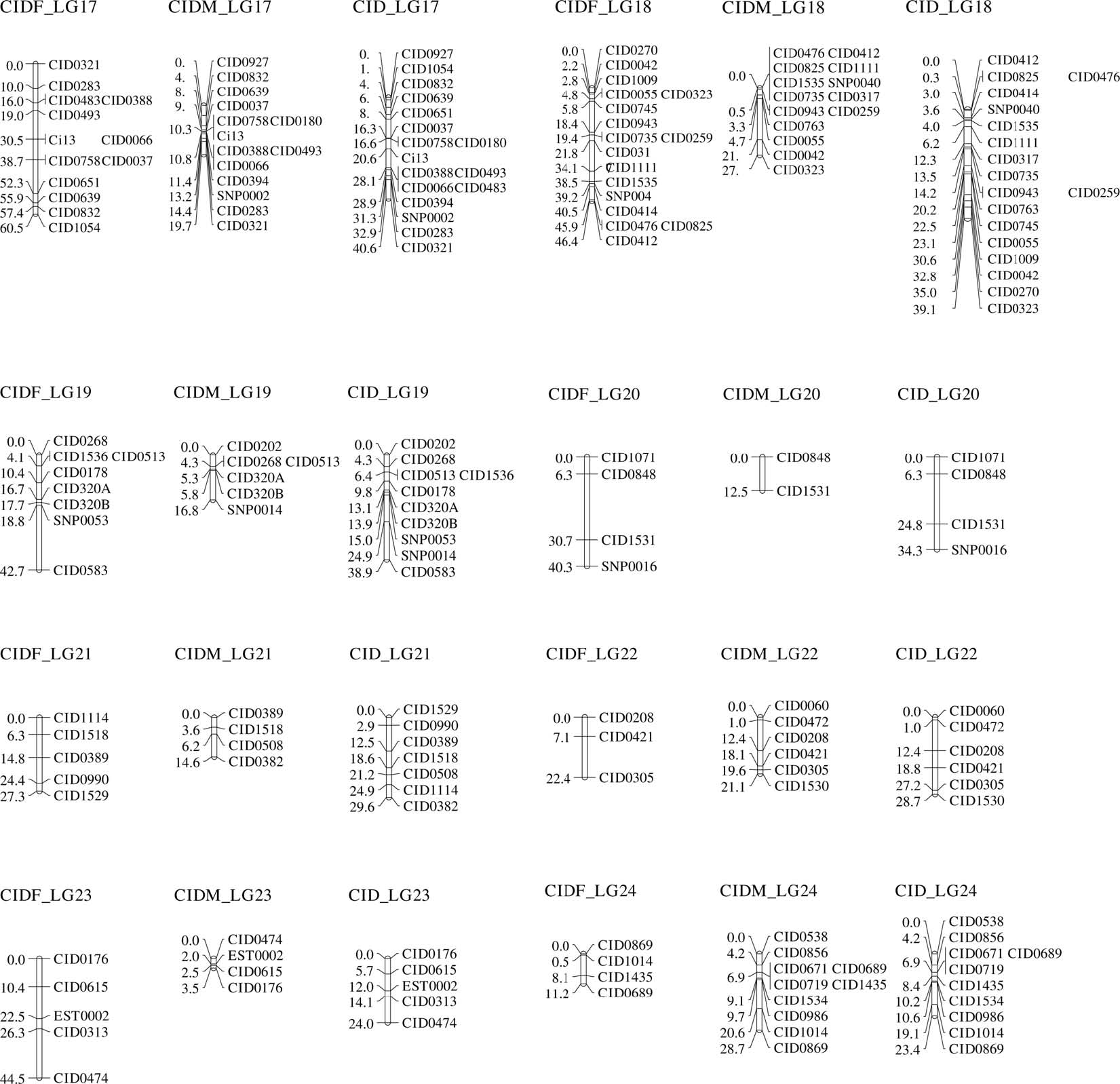 |
| Linkage groups 17-24. Permission granted from Dr. Yue Gen Hua. Taken from (Xia, et. al, 2010). Female linkage group is named CIDF. Male linkage group is named CIDM. The sex averaged linkage group is named CID. |
Type Information
The grass carp is first described by Valenciennes in 1844 in a book entitled “Synopsis of biological data on the grass carp, Ctenopharyngodon idella”. The first carp specimen was collected in 1982. It is 708 mm in length. It is currently catalogued at the Oklahoma State University Museum of Natural and Cultural History (OKSU 11356) (Shireman & Smith, 1983).
.
Literature and References
Bjergo, C., Boydstun, C., Crosby, M., Kokkanakis, S., & Sayers, R. (1995). Non-native aquatic species in the United States and coastal waters. Retrieved October 21, 2011, from U.S. Department of the Interior, National Biological Service: http://biology.usgs.gov/s+t/index.htm
Cross, D. (1969). Aquatic Weed Control using Grass Carp. Journal of Fish Biology , 1 (1), 27-30.
Krykhtin, M., & Gorbach, E. (1981). Reproductive ecology of the grass carp, Ctenopharyngodon idella, and the silver carp, Hypophthalmichthys molitrix, in the Amur Basin. Journal of Ichthyology , 21 (2), 109-123.
Liu, F., Xia, J., Bai, Z., Fu, J., Li, J., & Yue, G. (2009). High genetic diversity and substantial population differentiation in grassnext termprevious termcarpnext term (Ctenopharyngodon idella) revealed by microsatellite analysis. Aquaculture , 297 (1-4), 51-56.
Rohner, N., Bercsenyi, M., Orban, L., Kolanczyk, M., Linke, D., Brand, M., et al. (2009). Duplicatio of fgfr1 permits Fgf signaling to serve as a target for selection during domestication. Current Biology , 19, 1642-1647.
Shireman, J., & Smith, C. (1983). Synopsis of biological data on the grass carp, Ctenopharyngodon idella. Food and Aquaculture Organization Synopsis , 135, 86.
Xia, J., Liu, F., Zhu, Z., Fu, J., Feng, J., Li, J., et al. (2010). A consensus linkage map of the grass carp (Ctenopharyngodon idella) based on microsatellites and SNPs. BMC Genomics , 11 (135), 1471-2164.
Readers Comments
| Subject | Author | Replies | Views | Last Message |
|---|---|---|---|---|
| No Comments | ||||